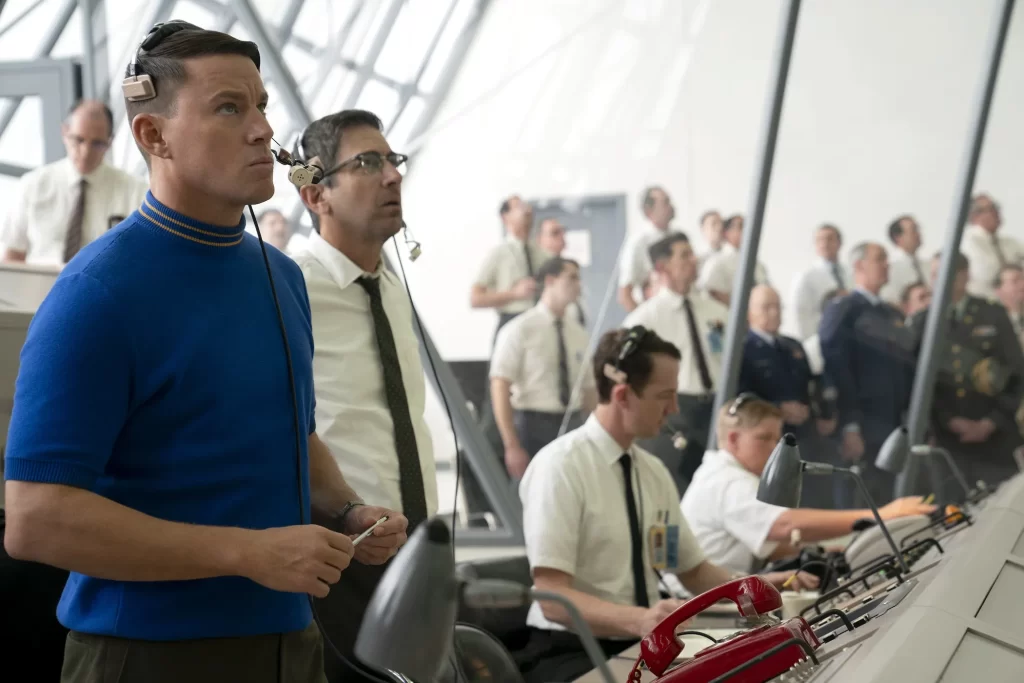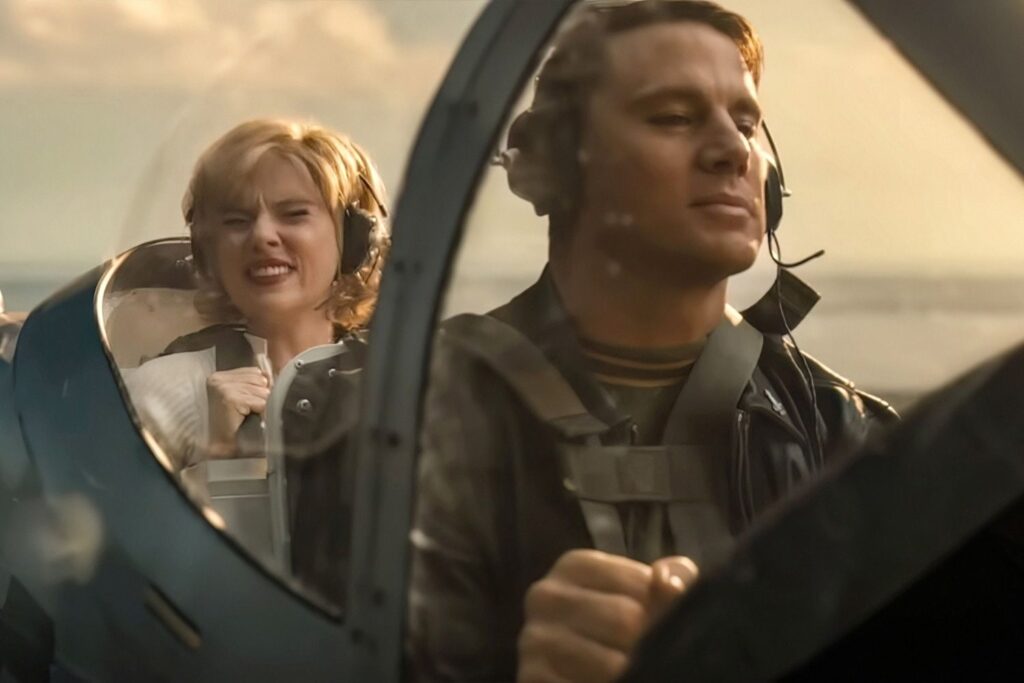
Remember movie stars? Those fabulously attractive celebrities who compelled audiences to flock to theaters in droves by sheer virtue of their names appearing on the marquee? They’re back in Fly Me to the Moon, a fizzy, fitful romantic comedy stocked with bright colors, lithe bodies, and a smattering of funny lines. It’s set in the ’60s and could have been made then too, even if its throwback vibes are often as clumsy as they are charming.
In the spirit of plucky wholesomeness that the movie tries to evoke, let’s start with the good stuff: Scarlett Johansson and Channing Tatum. And also Scarlett Johansson and Channing Tatum’s clothes. The costume designer, Mary Zophres (a regular collaborator with both Damien Chazelle and the Coen Brothers), develops the film’s characters with greater efficiency and style than Rose Gilroy’s clunky screenplay. Tatum, with his bull neck and broad shoulders, is outfitted in an array of tight-fitting sweaters that convey the swelling frustration of a robust leader whose vision is thwarted by external forces. Johansson, in contrast, is the picture of crisply tailored elegance, gliding through the picture in pastel dresses that accentuate her authority as well as her curves.

Such juxtaposition might suggest an oil-and-water pairing, but Kelly Jones (Johansson) and Cole Davis (Tatum) aren’t really oppositional. To the contrary, when they meet cute in a Cape Canaveral diner, their mutual attraction is obvious and instantaneous—so much so that Kelly literally catches on fire. Yet the relationship that inevitably flowers between them is less personal than professional. The year is 1968, and the Space Race is going poorly for the Americans; Cole, a former astronaut whose congenital defect forced him into the ground-bound role of launch director, is charged with shepherding the Apollo 11 mission, whose prospects appear increasingly dim in light of NASA’s depleted funding. A shadowy CIA spook (Woody Harrelson) pinpoints the problem as a failure of marketing, and he hires Kelly—a New York advertising whiz who in Mad Men terms is a hybrid of Don Draper and Joan Harris—to spice up the agency’s image.
This is a faintly silly conceit, but for a solid chunk of its runtime, Fly Me to the Moon coasts on the airy appeal of its lead actors. Johansson, freed from the hard-boiled angst of franchise roles like Black Widow, reminds you of her comedic grace, waltzing through the scenery with a honeyed lightness that doesn’t diminish her intelligence; the early sequence of Kelly glad-handing a trio of ramrod Ford execs plays like a cheshire cat sweet-talking some mice before swallowing them whole. Tatum has a harder job, given that Cole is defined by his impotent stubbornness, but he manages to slip some winking self-deprecation inside his all-American squareness. (Kudos as well to Anna Garcia, who invests the stock role of Kelly’s loyal assistant with some quick-witted personality; for his part, Ray Romano is largely wasted as Cole’s staunch lieutenant, but he’s worth it for the way he lights up when Kelly informs him that he’s slated to write the foreword to a book that doesn’t exist.) The scenes of Kelly schmoozing her way through NASA’s Florida branch, turning Cole’s stoic crew into starstruck fanboys, are irresistible for how they puncture the solemnity of scientific achievement with playful insouciance.

Fly Me to the Moon might have worked perfectly well as a buoyant workplace comedy, but Gilroy’s script has a grander plot in mind. Harrelson’s operative, on marching orders from Tricky Dick himself, determines that the televised success of the Apollo 11 landing is too critical to the nation’s global reputation to be left to the astronauts. He thus tasks Kelly with the secret assignment of fabricating an alternate version—complete with a rock-strewn film set, helmeted actors, and a pretentious director (Jim Rash) who says things like “Kubrick’s a hack”—that will be piped into viewers’ homes, with nobody (including Cole) the wiser.
This development is designed to imbue Fly Me to the Moon with a frisson of tension, but it ends up doing the opposite; the cheery enthusiasm that animates the movie’s first half deflates as the narrative shifts toward stale set pieces and phony intrigue. Our director here is Greg Berlanti, best known for orchestrating the superhero-glutted Arrowverse on the CW; he’s a competent blocker of dialogue scenes and mostly stays out of his actors’ way, but he’s hopeless when it comes to staging an exciting caper. The film’s third act—involving elements like a stolen television, a discreetly repaired camera, and a recurring black cat—is a fumbling misfire, failing to generate the slightest semblance of suspense.

It’s disappointing, because when Fly Me to the Moon just relaxes in the presence of its good-looking stars—as when Cole treats Kelly to a meal from a hole-in-the-wall hot dog stand or takes her for an aerial joyride in his two-seater—it’s delightful company. But then the screenplay feels obligated to burden its heroes with tragic backstories; Cole remains haunted by the Apollo 1 fire, while Kelly is withholding a dark past whose reveal improbably resembles the plot twist in Longlegs. The irony is obvious: Here’s a movie about a moon-landing conspiracy that makes it till it fakes it.
Grade: B-
Jeremy Beck is the editor-in-chief of MovieManifesto. He watches more movies and television than he probably should.
